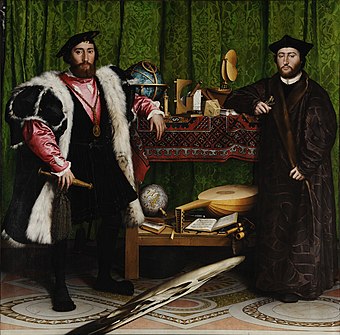| The Ambassadors | |
|---|---|
 | |
| Artist | Hans Holbein the Younger |
| Year | 1533 |
| Medium | Oil on oak |
| Dimensions | 207 cm × 209.5 cm (81 in × 82.5 in) |
| Condition | Restored 1996 |
| Location | National Gallery, London |
| Website | National Gallery page |
The Ambassadors is a 1533 painting by Hans Holbein the Younger. Also known as Jean de Dinteville and Georges de Selve,[1] after the two people it portrays, it was created in the Tudor period, in the same year Elizabeth I was born. Franny Moyle speculates that Elizabeth's mother, Anne Boleyn, then Queen of England, might have commissioned it as a gift for Jean de Dinteville, the French ambassador, portrayed on the left.[2] De Selve was a Catholic Bishop.
As well as being a double portrait, the painting contains a still life of meticulously rendered objects, the meaning of which is the cause of much debate. An array of expensive scientific objects, related to knowing the time and the cosmos are prominently displayed. Several refer to Rome, the seat of the Pope. A second shelf of objects shows a lute with a broken string, a symbol of discord, next to a hymnal composed by Martin Luther.
It incorporates one of the best-known examples of anamorphosis in painting. While most scholars have taken the view that the painting should be viewed side on to see the skull, others believe a glass tube was used to see the skull head on. Either way, death is both prominent and obscured until discovered. Less easily spotted is a carving of Jesus on a crucifix, half hidden behind a curtain at the top left.
The Ambassadors has been part of London's National Gallery collection since its purchase in 1890. It was extensively restored in 1997, leading to criticism, in particular that the skull's dimensions had been changed.
- ^ National Gallery 2018.
- ^ Moyle 2021, pp. 221–222.